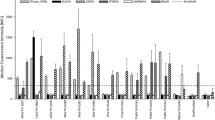Summary
Potato mop-top virus (PMTV) was most easily detected in potato leaf material by ELISA which proved more reliable than ISEM or inoculation of indicator plants with sap or extracted nucleic acid. Nucleic acid hybridisation tests using complementary DNA (cDNA) to PMTV were more reliable than ELISA, ISEM or inoculation of indicator plants for detecting PMTV in tissue from spraing-affected tubers. Unreliable results were obtained when cDNA was used to detect virus in tubers with deep cracks, indicative of secondary symptoms.
Tuber tissue examined by ISEM taken from either side of a necrotic arc show that relative virus concentration varies considerably over very short distances. ELISA on sprouts and stems from spraing-affected tubers also show that virus distribution is highly variable.
Zusammenfassung
Potato-Mop-Top-Virus wurde in Blattmaterial von Kartoffeln durch den ELISA nachgewiesen, welcher sich als verlässlicher erwies als ISEM oder Inokulation von Indikator-pflanzen mit Saftextrakten oder extrahierter Nukleinsäure. Tabelle 1 zeigt, dass Saftextrakte oder extrahierte Nukleinsäure von 7 von 13 Symptom-aufweisenden Kartoffel-pflanzen auch Symptome aufNicotiana debneyi und/oderChenopodium amaranticolor hervorriefen. Mittels ELISA konnte von Symptom-aufweisendem Blattmaterial PMTV in 10 von 12 verdächtigen Pflanzen ermittelt werden, im Vergleich dazu mittels ISEM nur bei 7 von 12 Pflanzen (Tabelle 2). Knollen mit fleckenartigen Symptomen (‘spraing’) wurden angekeimt und 4 Tage lang bei Licht oder Dunkelheit aufbewahrt. Andere Knollen wuchsen bis zur Reife unter Gewächshausbedingungen. Mittels ELISA konnte bei Keimen und Trieben PMTV öfter in Keimen von im Dunkeln gehaltenen Knollen nachgewiesen werden (Tabelle 3). ISEM, in 5 mm-Abständen an der Oberfläche von Knollen, von 2 cm innerhalb eines nekrotischen Krieses bis 2 cm ausserhalb des nekrotischen Kreises genommen, zeigte, dass der Virusgehalt im Bereich sich entwickelnder Nekrosen am grössten war (Tabelle 4). Nukleinsäure-Hybridisationstests bei Verwendung komplementärer DNA gegen PMTV war verlässlicher als ELISA, ISEM oder Inokulation von Indikatorpflanzen zum Nachweis von PMTV im Gewebe von Knollen mit Flecken. Unzuverlässige Ergebnisse ergaben sich, wenn cDNA zum Nachweis des Virus in Knollen mit sekundären Symptomen verwendet wurde (Tabelle 5).
Résumé
Le virus du mop-top de la pomme de terre a été détecté dans du matériel foliaire de pomme de terre par ELISA qui s'est révélé plus fiable que l'ISEM ou que l'inoculation de plantes indicatrices avec des extraits de sève ou d'acide nucléique. Le tableau 1 montre que les extraits de sève ou d'acide nucléique de 7 plantes sur 13 de pommes de terre présentant des symptômes ont induit des symptômes surNicotiana debneyi et/ouChenopodium amaranticolor. ELISA appliqué sur du matériel foliaire présentant des symptômes, a détecté le PMTV dans 10 plantes suspectes sur 12 comparé à 7 sur 12 avec l'ISEM (Tableau 2). Les tubercules présentant des symptômes d'arcs nécrotiques ont été mis à germer et placés ou bien à la lumière ou bien à l'obscurité pendant 4 jours. D'autres tubercules ont été cultivés jusqu'à maturité en conditions de serre. Les tests ELISA sur germes et tiges ont détecté le PMTV plus souvent dans les germes de tubercules conservés à la lumière (Tableau 3). L'ISEM sur des tissus de tubercules prélevés tous les 5 mm à la surface d'un tubercule, à partir de 2 cm à l'intérieur d'un arc nécrotique jusqu'à 2 cm à l'extérieur de l'arc, a montré que la teneur en virus était plus forte dans une zone où se développe la nécrose (Tableau 4). Les tests d'hybridation de l'acide nucléique utilisant de l'ADN complémentaire de l'ARN du PMTV ont été plus fiables qu'ELISA, l'ISEM ou l'inoculation de plantes indicatrices pour détecter le PMTV dans le tissu de tubercules montrant des arcs nécrotiques. Des résultats peu fiables ont été obtenus quand le cDNA a été utilisé pour détecter le virus dans les tubercules présentant des symptômes secondaires (Tableau 5).
Similar content being viewed by others
References
Brenchley, G. H. & H. J. Wilcox, 1979. In: J. S. W. Dickens, Potato diseases, p. 95. Her Majesty's Stationary Office.
Calvert, E. L., 1968. The reaction of potato varieties to potato mop-top virus. Record of Agricultural Research No 17: 31–40. Ministry of Agriculture for Northern Ireland.
Calvert, E. L. & B. D. Harrison, 1966. Potato mop-top virus, a soil-borne virus.Plant Pathology 15: 134–139.
Clark, M. F. & A. N. Adams, 1977. Characteristics of the microplate method of enzymelinked immunosorbent assay for the detection of plant viruses.Journal of General Virology 34: 475–483.
Harrison, B. D., 1970. Tobacco rattle virus. CMI/AAB Descriptions of plant viruses number 12 (June 1970).
Harrison, B. D., D. J. Robinson, W. P. Mowat, G. H. Duncan, 1983. Comparison of nucleic acid hybridisation and other tests for detecting tobacco rattle virus in narcissus plants and potato tubers.Annals of Applied Biology 102: 331–338.
Kassanis, B. & D. A. Govier, 1972. Potato aucuba mosaic virus. CMI/AAB Descriptions of plant viruses number 98 (October 1972).
McKay, J., 1969. Diseases of the potato caused by soil-borne viruses. I. The spraing mop-top syndrome.Journal of the Department of Agriculture for the Republic of Ireland 66: 3–15.
Murant, A. F., 1970. Tomato black ring virus. CMI/AAB Descriptions of plant viruses number 38 (October 1970).
Roberts, I. M. & B. D. Harrison, 1979. Detection of potato leaf roll and potato mop-top viruses by immunosorbent electron microscopy.Annals of Applied Biology 93: 289–297.
Robinson, D. J., H. Barker, B. D. Harrison & M. A. Mayo, 1980. Replication of RNA-1 of tomato black ring virus independently of RNA-2.Journal of General Virology 51: 317–326.
Salazar, L. F. & R. A. C. Jones, 1975. Some studies on the distribution and incidence of potato mop-top virus in Peru.American Potato Journal 52: 143–150.
Taylor, J. M., R. Illmensee & J. Summers, 1976. Efficient transcription of RNA into DNA by avian sarcoma virus polymerase.Biochimica et Biophysica Acta 442: 324–330.
Todd, J. M., 1965. Soil-borne virus diseases of potato. Scottish Plant Breeding Station Record 1965, p. 209.
Hoof, A. A. van & A. Rozendaal, 1969. Het voorkomen van ‘potato mop-top virus’ in Nederland.Netherlands Journal of Plant Pathology 75: 275.




